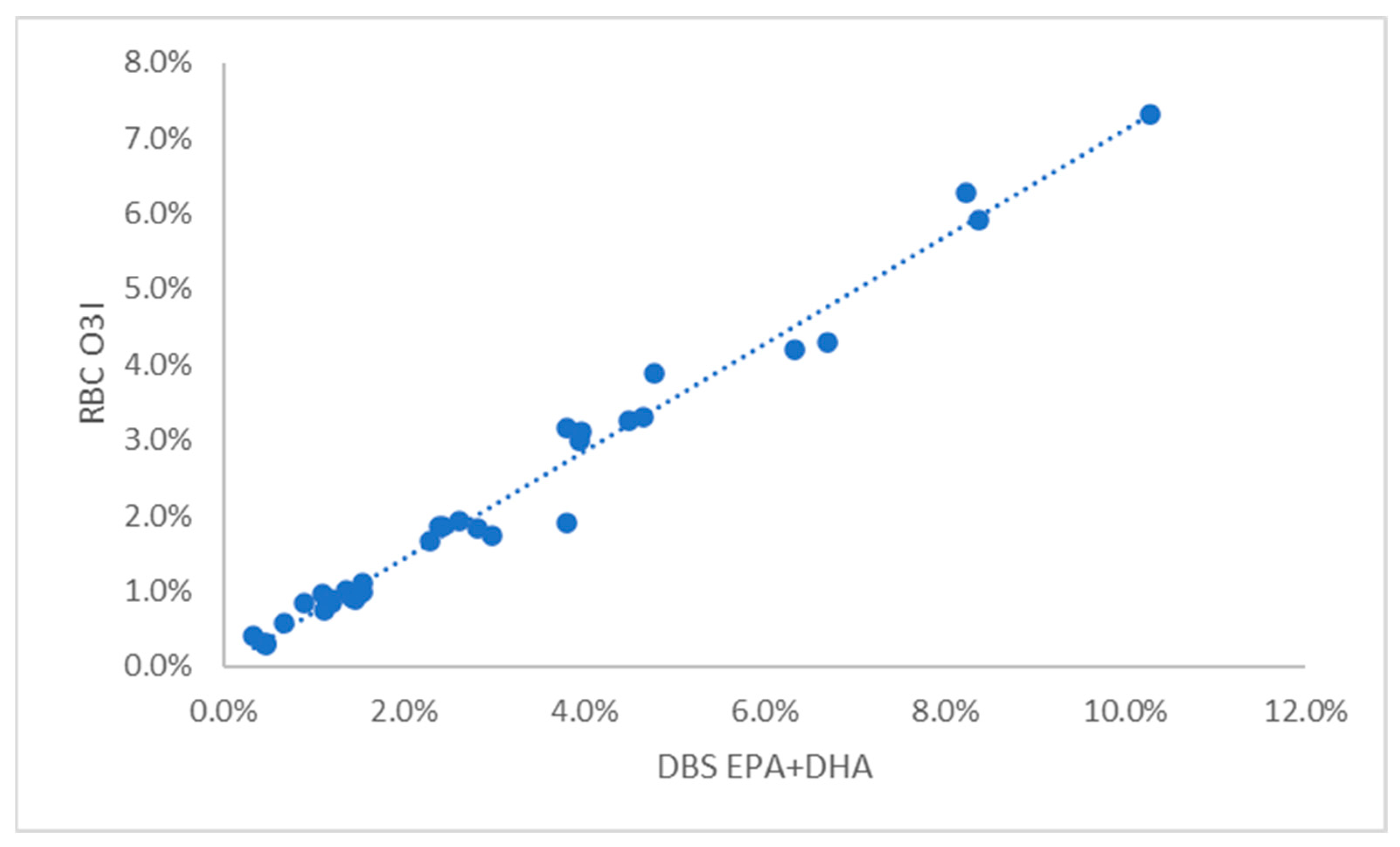Correction: Harris et al. Derivation of the Omega-3 Index from EPA and DHA Analysis of Dried Blood Spots from Dogs and Cats. Vet. Sci. 2023, 10, 13
Error in Table
| Species | Equation | R2 | O3I Equivalent of a DBS EPA + DHA of 4% | Approximate Range of O3I Values |
|---|---|---|---|---|
| Dog (n = 33) | y = 0.709x + 0.0002 | 0.98 | 2.9% | 0.3 to 7% |
| Cat (n = 10) | y = 0.690x + 0.0014 | 0.96 | 2.9% | 0.5 to 4% |
| Human (n = 100) | y = 1.114x + 0.014 | 0.88 | 5.9% | 2 to 12% |
Error in Figure
Text Correction
Reference
- Harris, W.S.; Jackson, K.H.; Carlson, H.; Hoem, N.; Dominguez, T.E.; Burri, L. Derivation of the Omega-3 Index from EPA and DHA Analysis of Dried Blood Spots from Dogs and Cats. Vet. Sci. 2023, 10, 13. [Google Scholar] [CrossRef] [PubMed]

Disclaimer/Publisher’s Note: The statements, opinions and data contained in all publications are solely those of the individual author(s) and contributor(s) and not of MDPI and/or the editor(s). MDPI and/or the editor(s) disclaim responsibility for any injury to people or property resulting from any ideas, methods, instructions or products referred to in the content. |
© 2023 by the authors. Licensee MDPI, Basel, Switzerland. This article is an open access article distributed under the terms and conditions of the Creative Commons Attribution (CC BY) license (https://creativecommons.org/licenses/by/4.0/).
Share and Cite
Harris, W.S.; Jackson, K.H.; Carlson, H.; Hoem, N.; Dominguez, T.E.; Burri, L. Correction: Harris et al. Derivation of the Omega-3 Index from EPA and DHA Analysis of Dried Blood Spots from Dogs and Cats. Vet. Sci. 2023, 10, 13. Vet. Sci. 2023, 10, 422. https://doi.org/10.3390/vetsci10070422
Harris WS, Jackson KH, Carlson H, Hoem N, Dominguez TE, Burri L. Correction: Harris et al. Derivation of the Omega-3 Index from EPA and DHA Analysis of Dried Blood Spots from Dogs and Cats. Vet. Sci. 2023, 10, 13. Veterinary Sciences. 2023; 10(7):422. https://doi.org/10.3390/vetsci10070422
Chicago/Turabian StyleHarris, William S., Kristina H. Jackson, Heather Carlson, Nils Hoem, Tonje E. Dominguez, and Lena Burri. 2023. "Correction: Harris et al. Derivation of the Omega-3 Index from EPA and DHA Analysis of Dried Blood Spots from Dogs and Cats. Vet. Sci. 2023, 10, 13" Veterinary Sciences 10, no. 7: 422. https://doi.org/10.3390/vetsci10070422
APA StyleHarris, W. S., Jackson, K. H., Carlson, H., Hoem, N., Dominguez, T. E., & Burri, L. (2023). Correction: Harris et al. Derivation of the Omega-3 Index from EPA and DHA Analysis of Dried Blood Spots from Dogs and Cats. Vet. Sci. 2023, 10, 13. Veterinary Sciences, 10(7), 422. https://doi.org/10.3390/vetsci10070422





